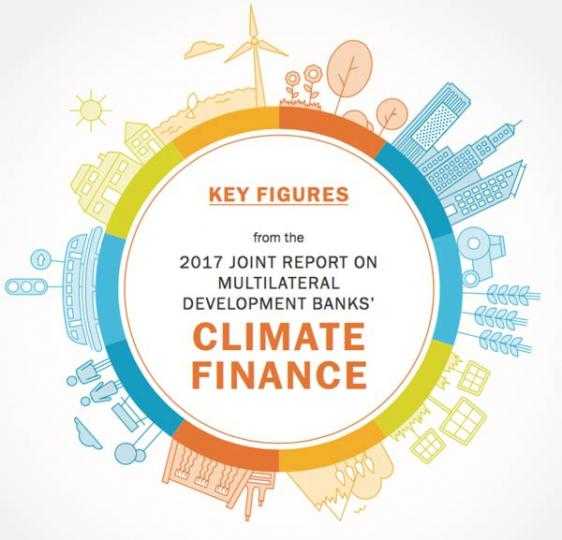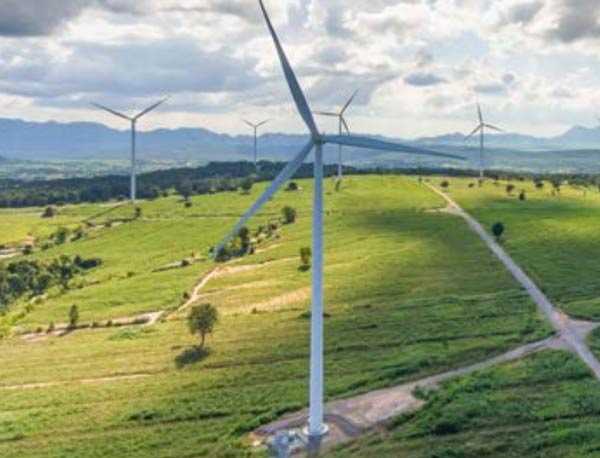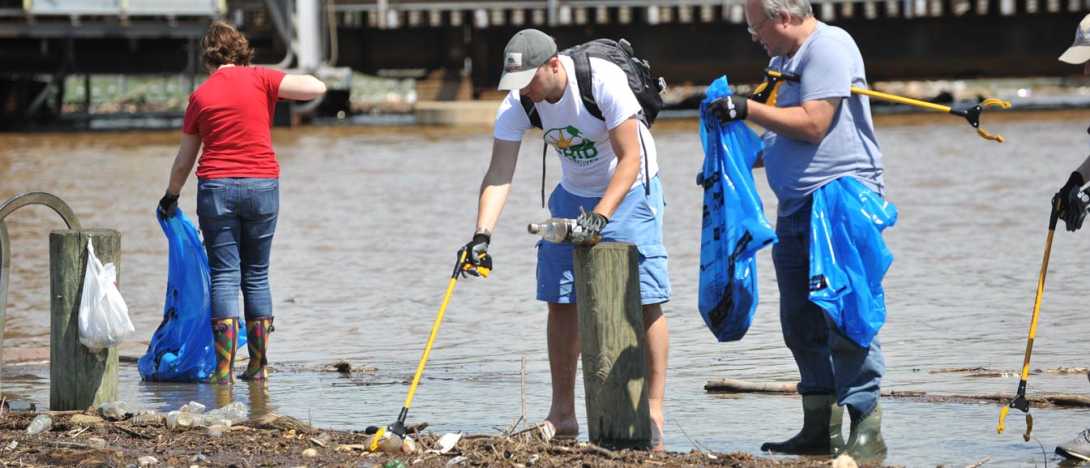


Are you 18-30 and taking part in activities to fight climate change? Send a 3-minute video for a chance to be a youth reporter at the UN Climate Change Conference in Poland in December. The deadline is on August 31, 2018.

 Video up to 3 minutes long
Video up to 3 minutes long
 Aged between 18 and 30
Aged between 18 and 30
 Spoken or subtitled English
Spoken or subtitled English
 Enter from any country
Enter from any country
 Submit by August 31, 2018
Submit by August 31, 2018Category One: Responsible production & consumption
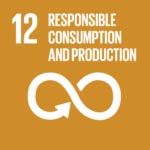
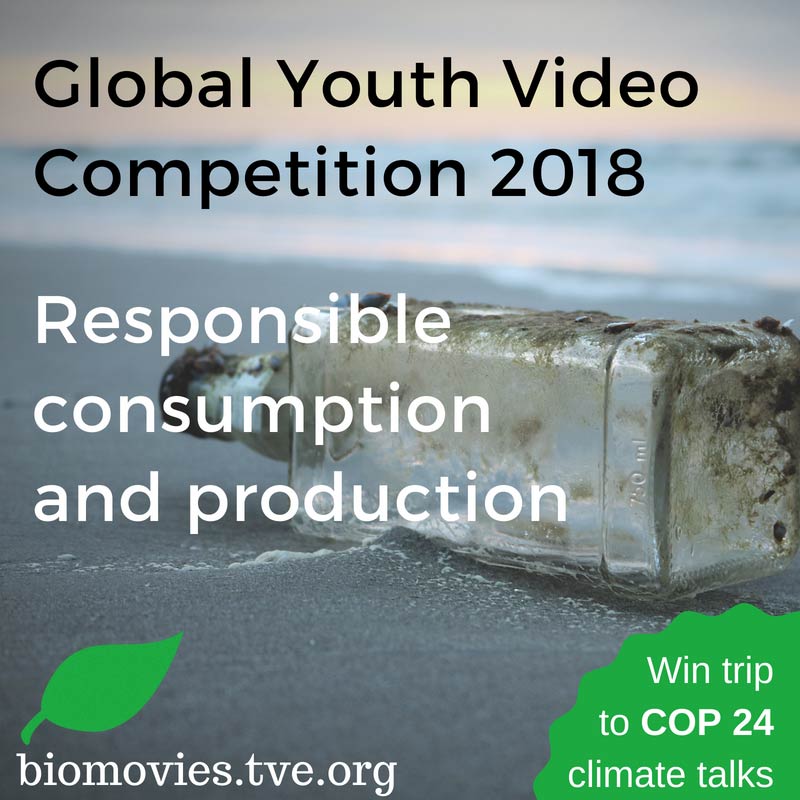

 Carrying out climate friendly solutions/ideas on how to promote sustainable production or consumption
Carrying out climate friendly solutions/ideas on how to promote sustainable production or consumption
 Campaigns to promote behavioural change
Campaigns to promote behavioural change
 Initiatives to reduce emissions during the lifecycle of goods, in areas such as:
Initiatives to reduce emissions during the lifecycle of goods, in areas such as:
 unnecessary consumption
unnecessary consumption
 sustainable fashion
sustainable fashion
 sharing economy
sharing economy
 reusing goods and materials
reusing goods and materials
 transporting goods
transporting goods
 locally focused economy
locally focused economy
 reducing waste
reducing wasteCategory Two: Green and climate friendly jobs
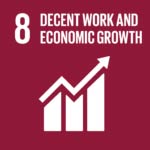
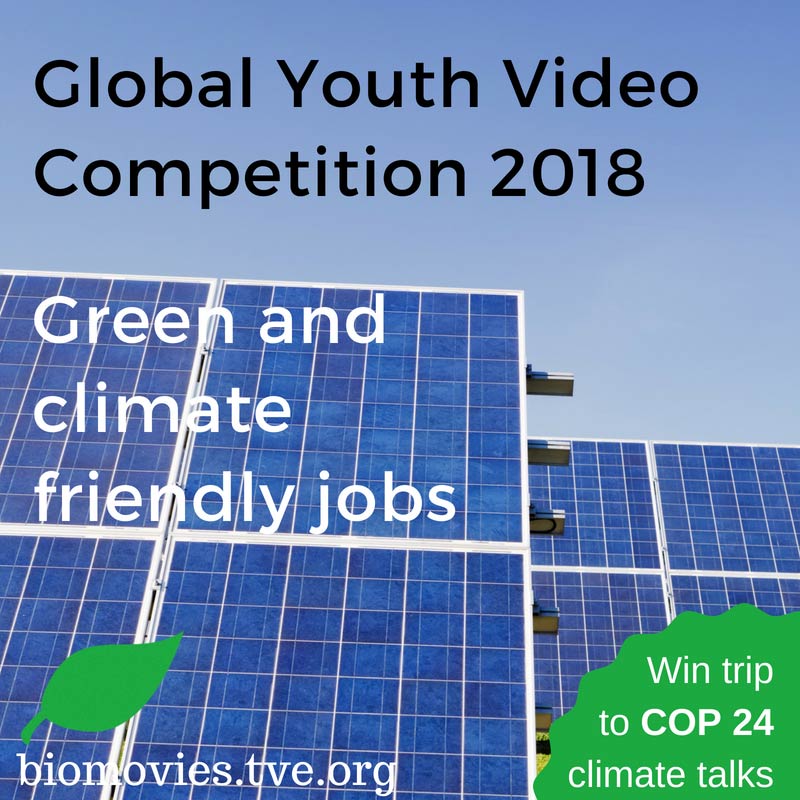

 Work or new businesses that improve the economy and addresses climate change
Work or new businesses that improve the economy and addresses climate change
 Green jobs and careers related to:
Green jobs and careers related to:
 Renewable energy
Renewable energy
 Food waste
Food waste
 Construction and infrastructure
Construction and infrastructure
 Transportation
Transportation
 Green design
Green design
 Technical and job-based training for green jobs
Technical and job-based training for green jobs
 Educational campaigns promoting sustainable employment
Educational campaigns promoting sustainable employment
 Research to develop a low-carbon economy
Research to develop a low-carbon economy



A wise investment in land supports you and your future. Your choices determine future scenarios for sustainable growth. The 2018 World Day to Combat Desertification (#2018WDCD) urges you to move away from unsustainable land use and make a difference by investing in the future of land under the slogan, “Land has true value – invest in it.”
We often use land as if it were a limitless resource, ignoring its role in our everyday lives. This negligence threatens food and water supply, biodiversity, and even human security itself. Short-sighted economic gains such as land grabbing, unplanned urban sprawl, unsustainable agriculture, and over-consumption lead to unsustainable land use, which eventually causes degradation and loss of critical ecosystem services. As a result, consumption of the Earth´s natural reserves has doubled in the last 30 years, with a third of the planet´s land already severely degraded.
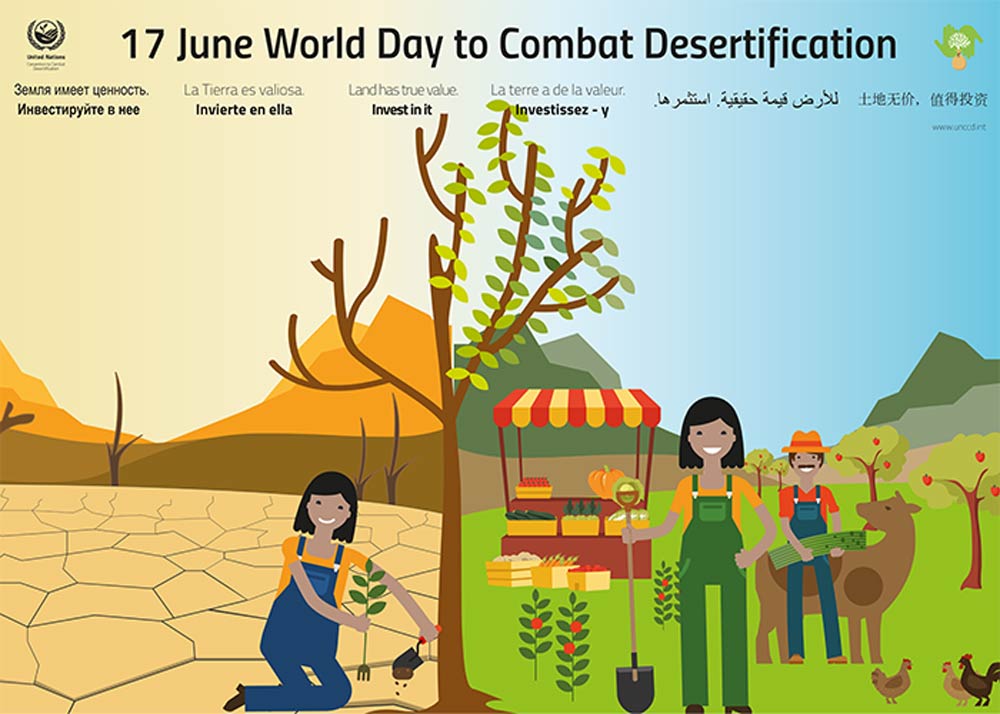
By turning land degradation into land restoration, we can realize the land´s full potential. Healthy and productive land can bring not only environmental but also significant economic gains. For example, case studies from the Economics of Land Degradation Initiative (2015) indicate that:

 The annual loss of 75 billion tons of soil from arable land leads a missing opportunity for economic benefits of USD 400 billion per year globally
The annual loss of 75 billion tons of soil from arable land leads a missing opportunity for economic benefits of USD 400 billion per year globally

 Taking action against soil erosion over 105 million hectares would save up to USD 62.4 billion in net present value over the next 15 years
Taking action against soil erosion over 105 million hectares would save up to USD 62.4 billion in net present value over the next 15 years

 Enhancing carbon stocks through agricultural soils alone can create potential value on the carbon market from USD 96-480 billion annually
Enhancing carbon stocks through agricultural soils alone can create potential value on the carbon market from USD 96-480 billion annually
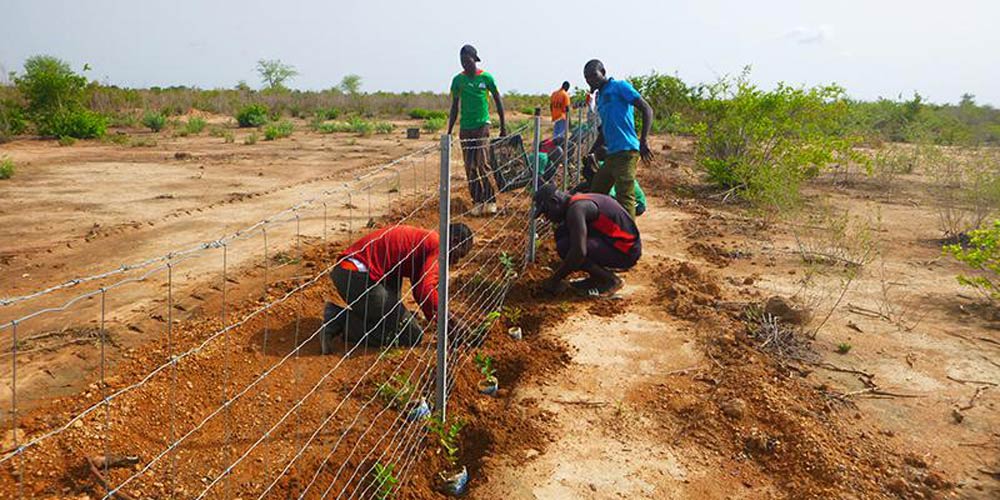
Burkina Faso: 20 000 trees are planted to create living hedges. Photo Credits:UNCCD
Sustainable land management (SLM) is a wise investment for economic growth that does not compromise resilient livelihoods. It is key to safeguarding and managing the quality of the land by balancing its biological and economic potential. Moreover, land can play a vital role in linking multiple Sustainable Development Goals by harnessing synergies while minimizing potential conflicts and trade-offs. SLM can give tremendous momentum to positive change. By safeguarding life on land, we deliver for all life on Earth.
This is the true value of land.
Every one of us has a role to play. Farmers can invest in smart agriculture that leads to higher yields despite a reduction in inputs like pesticides. Policy makers and land managers can support bio-economy by investing in new SLM technologies and processes. Consumers can spend their money on organic and fairly traded products to avoid land degradation. There are many more ways to invest in land wisely.

Vietnam: Delegates of the WDCD meeting plant 2 000 trees at Dien Bien Dong district, Dien Bien province to promote sustainable land management practices. Photo Credits:UNCCD
We can all contribute to and benefit from investing in SLM – whether we act as consumers, producers, corporations, or governments. Changes in behavior and adoption of more efficient planning and practices can guarantee that sufficient land resources are available long-term to meet our ambitions for and to provide sustainable livelihoods.
The choice is ours. Know the true value of land and invest in it.
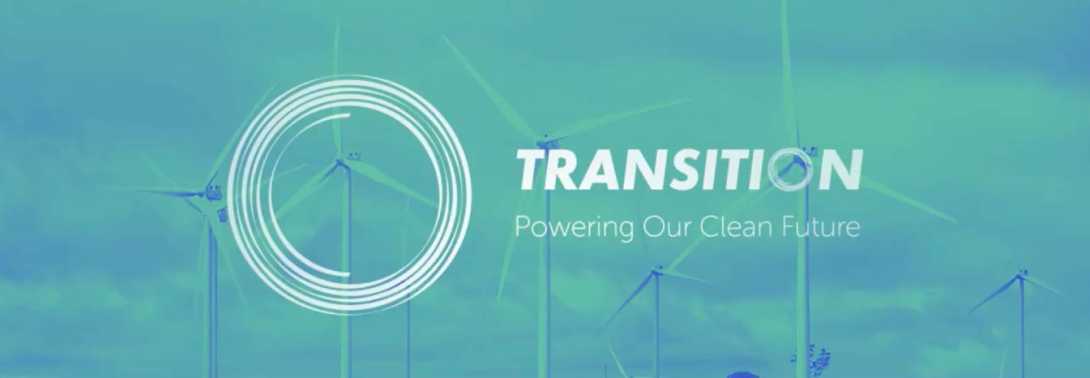
Under the High Patronage of His Serene Highness, Prince Albert II, Transition Monaco Forum, a new global platform committed to accelerating the transition towards a clean future across all sectors and industries, will convene global business leaders, policymakers, cleantech experts, and innovators at The Grimaldi Forum in Monaco from June 26-27, 2018.
In response to commitments made during COP 21 and the One Planet Summit, and by developing new business models combining prosperity and sustainability as well as identifying the latest technologies and implementing initiatives for companies to pioneer this change, Transition Monaco Forum aims to accelerate the ecological and energy transition.
The objectives of this exciting new initiative are to form a European hub of investors dedicated to financing the ecological and energy transition and to mobilize key stakeholders across all sectors to find concrete solutions for businesses to develop sustainably.
Gathered in Monaco, a country leading the energy transition, participants will debate the five critical enablers of the cleantech ecosystem: finance, regulation, innovation, cities and territories and new stakeholders.
Speaker Highlights

 H.S.H. Prince Albert II of Monaco (Monaco)
H.S.H. Prince Albert II of Monaco (Monaco)
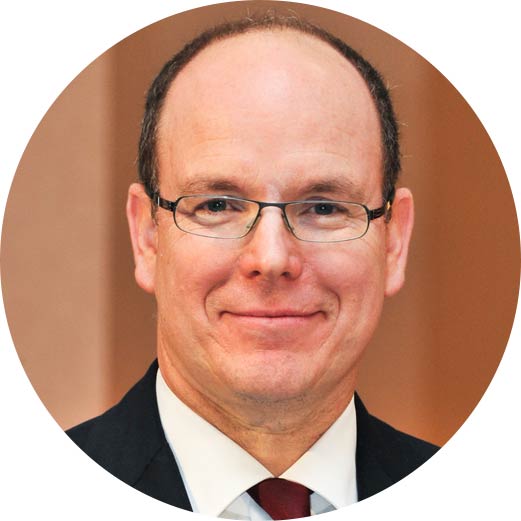

 Arnold Schwarzenegger, Founder, R20 Regions of Climate Action (USA)
Arnold Schwarzenegger, Founder, R20 Regions of Climate Action (USA)
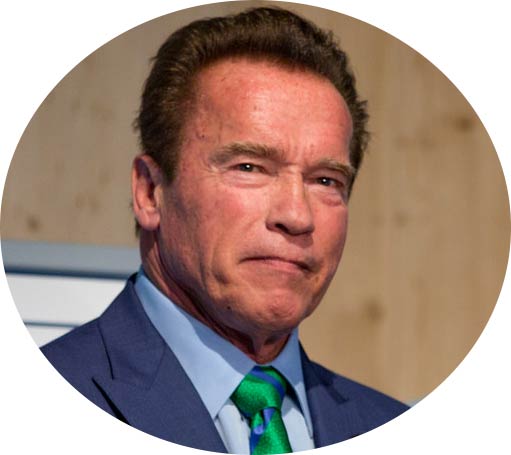

 Alzbeta Klein, Director and Global Head, Climate Business, International Finance Corporation (IFC) (USA)
Alzbeta Klein, Director and Global Head, Climate Business, International Finance Corporation (IFC) (USA)


 Anne Hidalgo, Mayor of Paris, Chair of C40 Cities Climate Leadership Group (France)
Anne Hidalgo, Mayor of Paris, Chair of C40 Cities Climate Leadership Group (France)

Other confirmed international speakers include:

 Olivier Biancarelli, General Director, Tractabel-Engie (France)
Olivier Biancarelli, General Director, Tractabel-Engie (France)

 Erik Brandsma, General Director, Swedish Energy (Sweden)
Erik Brandsma, General Director, Swedish Energy (Sweden)

 Graciela Chichilniski, Economist and Nobel Prize Winner, Columbia University (USA)
Graciela Chichilniski, Economist and Nobel Prize Winner, Columbia University (USA)

 Filipe de Botton, CEO, Logoplaste (Portugal)
Filipe de Botton, CEO, Logoplaste (Portugal)

 Matthieu de Chanville, Deputy Head of Alliance Ventures, Renault-Nissan-Mitsubishi (France)
Matthieu de Chanville, Deputy Head of Alliance Ventures, Renault-Nissan-Mitsubishi (France)

 Jérôme Delafosse, Explorer and Expedition Leader, Energy Observer (France)
Jérôme Delafosse, Explorer and Expedition Leader, Energy Observer (France)

 Rinat Guy, Chief Innovation Officer, Municipality of Tel Aviv (Israel)
Rinat Guy, Chief Innovation Officer, Municipality of Tel Aviv (Israel)

 Eric Harr, Co-Founder & CEO, Laudato Si'Challenge (USA)
Eric Harr, Co-Founder & CEO, Laudato Si'Challenge (USA)

 Paul Holthus, President & CEO, World Ocean Council
Paul Holthus, President & CEO, World Ocean Council

 Margaret Kuhlow, Finance Practice Leader, WWF (USA)
Margaret Kuhlow, Finance Practice Leader, WWF (USA)

 William Kwende, Chairman, Agritech (Burkina Faso)
William Kwende, Chairman, Agritech (Burkina Faso)

 Claude Nahon, Sustainable Development, Senior Vice President, EDF (France)
Claude Nahon, Sustainable Development, Senior Vice President, EDF (France)

 Francis O’ Sullivan, Director, Energy Initiative, MIT (USA)
Francis O’ Sullivan, Director, Energy Initiative, MIT (USA)

 Gunter Pauli, Businessman and Author of the Blue Economy (Belgium)
Gunter Pauli, Businessman and Author of the Blue Economy (Belgium)

 Nancy Pfund, Managing Partner, DBL Partners (USA)
Nancy Pfund, Managing Partner, DBL Partners (USA)

 David Rosenberg, CEO, Aerofarms (USA)
David Rosenberg, CEO, Aerofarms (USA)

 Carlos Sallé, Director of Energy Policies and Climate Change, Iberdrola (Spain)
Carlos Sallé, Director of Energy Policies and Climate Change, Iberdrola (Spain)

 Riaz Siddiqi, Founder and Managing Partner, Denham Capital (USA)
Riaz Siddiqi, Founder and Managing Partner, Denham Capital (USA)

 Sylvain Vanston, Chief Sustainability Officer, AXA (France)
Sylvain Vanston, Chief Sustainability Officer, AXA (France)
Find here the full conference program and the full list of confirmed speakers
A comprehensive annual overview of the state of renewable energy.
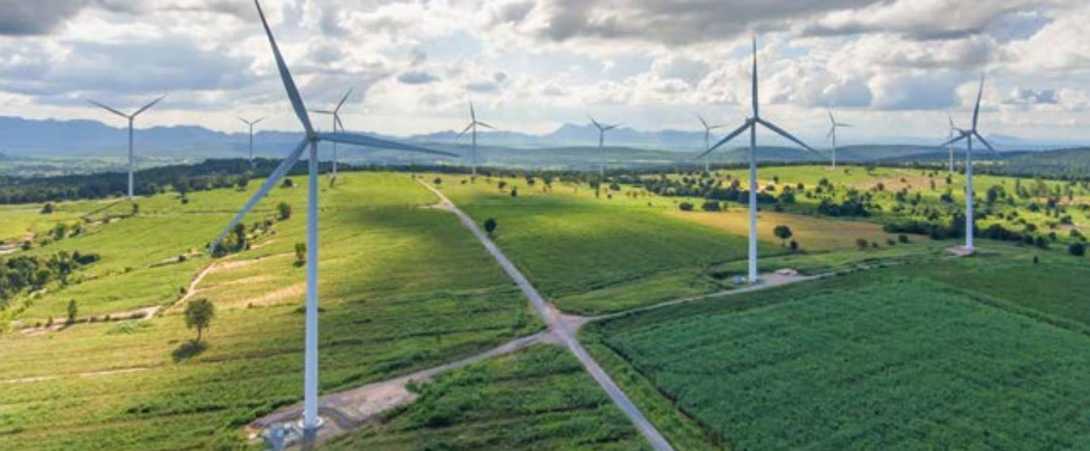
Renewable power accounted for 70% of net additions to global power generating capacity in 2017, the largest increase in renewable power capacity in modern history, according to REN21’s Renewables 2018 Global Status Report (GSR). But the heating, cooling and transport sectors – which together account for about four-fifths of global final energy demand – continue to lag far behind the power sector. The GSR, published today, is the most comprehensive annual overview of the state of renewable energy worldwide.
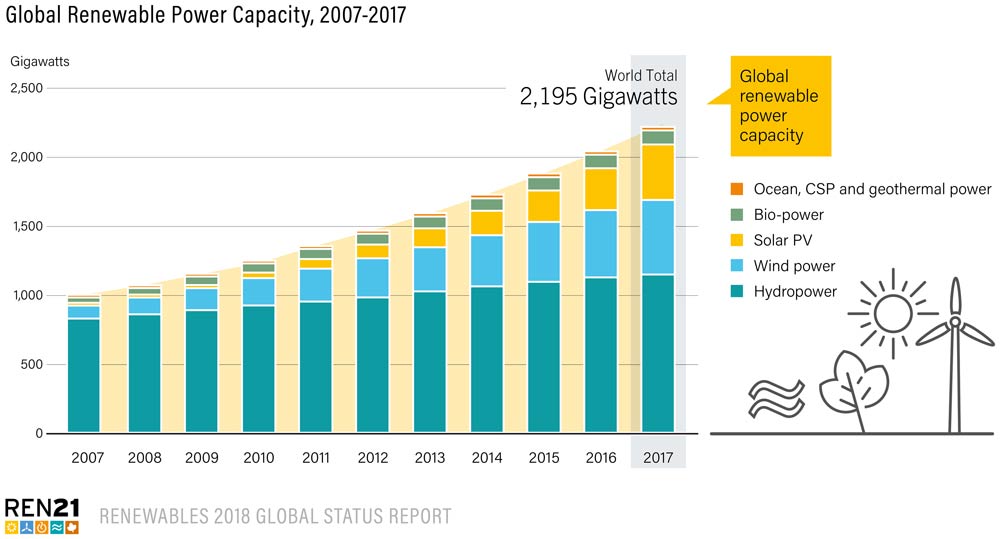
New solar photovoltaic (PV) capacity reached record levels: Solar PV additions were up 29% relative to 2016, to 98 GW. More solar PV generating capacity was added to the electricity system than net capacity additions of coal, natural gas and nuclear power combined. Wind power also drove the uptake of renewables with 52 GW added globally.
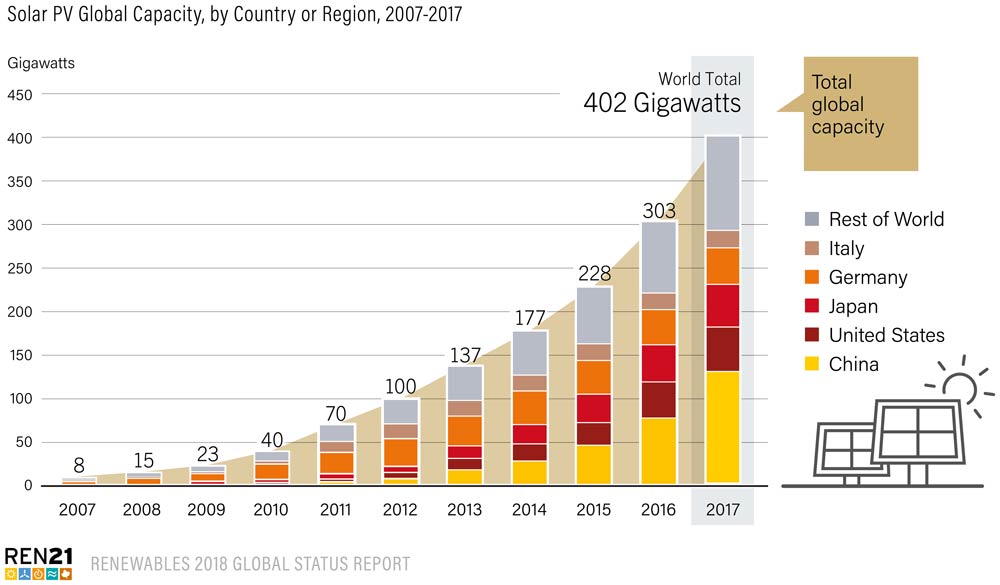
Investment in new renewable power capacity was more than twice that of net, new fossil fuel and nuclear power capacity combined, despite large, ongoing subsidies for fossil fuel generation. More than two-thirds of investments in power generation were in renewables in 2017, thanks to their increasing cost-competitiveness – and the share of renewables in the power sector is expected to only continue to rise.
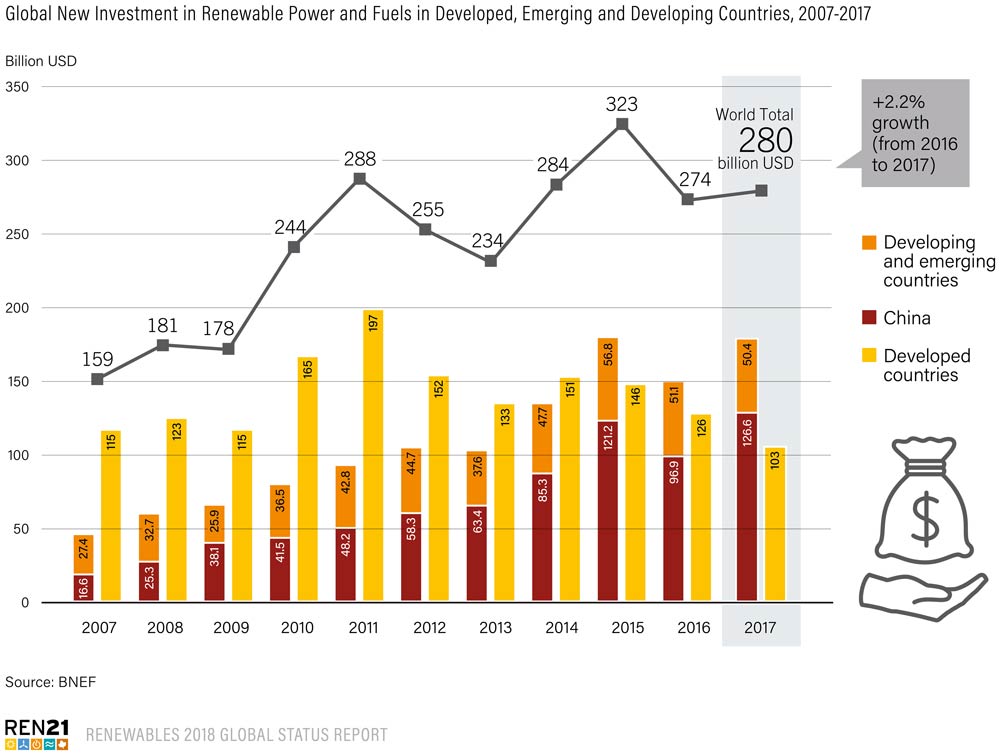
Investment in renewables was regionally concentrated: China, Europe and the United States accounted for nearly 75% of global investment in renewables in 2017. However, when measured per unit of gross domestic product (GDP), the Marshall Islands, Rwanda, the Solomon Islands, Guinea-Bissau, and many other developing countries are investing as much as or more in renewables than developed and emerging economies.
Both energy demand and energy-related CO2 emissions rose substantially for the first time in four years. Energy-related CO2 emissions rose by 1.4%. Global energy demand increased an estimated 2.1% in 2017 due to economic growth in emerging economies as well as population growth. Renewable energy uptake is not keeping pace with this increasing energy demand and the continuous investment in fossil and nuclear capacity.
In the power sector, the transition to renewables is under way but is progressing more slowly than is possible or desirable. A commitment made under the 2015 Paris climate agreement to limit global temperature rise to “well below” 2 degrees Celsius above pre-industrial levels makes the nature of the challenge much clearer.
If the world is to achieve the target set in the Paris agreement, then heating, cooling and transport will need to follow the same path as the power sector – and fast. These sectors have seen:
Little change in renewables uptake in heating and cooling: Modern renewable energy supplied approximately 10% of total global heat production in 2015. National targets for renewable energy in heating and cooling exist in only 48 countries around the world, whereas 146 countries have targets for renewable energy in the power sector.
Small changes are under way. In India, for example, installations of solar thermal collectors rose approximately 25% in 2017 as compared to 2016. China aims to have 2% of the cooling loads of its buildings come from solar thermal energy by 2020.
In transport, increasing electrification is offering possibilities for renewable energy uptake despite the dominance of fossil fuels: More than 30 million two- and three-wheeled electric vehicles are being added to the world’s roads every year, and 1.2 million passenger electric cars were sold in 2017, up about 58% from 2016. Electricity provides 1.3% of transport energy needs, of which about one-quarter is renewable, and biofuels provide 2.9%. Overall, however, 92% of transport energy demand continues to be met by oil, and only 42 countries have national targets for the use of renewable energy in transport.
For these sectors to change, the right policy frameworks need to be put in place, driving innovation and the development of new renewable energy technologies in the sectors that are lagging.

“Equating ‘electricity’ with ‘energy’ is leading to complacency. We may be racing down the pathway towards a 100% renewable electricity future, but when it comes to heating, cooling and transport, we are coasting along as if we had all the time in the world. Sadly, we don’t.”

Rana Adib, Executive Secretary of REN21

“To make the energy transition happen there needs to be political leadership by governments – for example by ending subsidies for fossil fuels and nuclear, investing in the necessary infrastructure, and establishing hard targets and policy for heating, cooling and transport. Without this leadership, it will be difficult for the world to meet climate or sustainable development commitments.”

Arthouros Zervos, REN21 Chair
